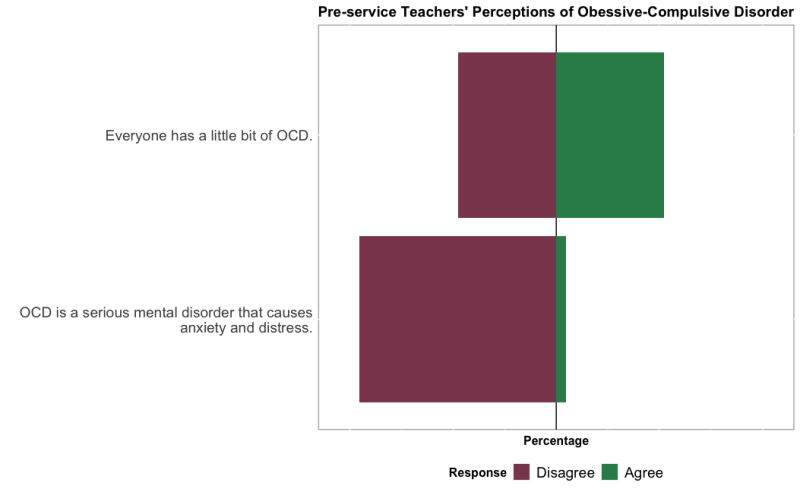The “Invisible” Disorder: OCD Stigma & How We Move Forward
The “Invisible” Disorder: OCD Stigma & How We Move Forward

When I asked to use my dissertation to look into current societal perceptions of Obsessive-Compulsive Disorder (OCD), I was told to wait to change the world until after I earned my PhD. Fast forward to a successful defense over predictors of expectation fulfillment, and I was ready to see what I could do to decrease societal stigma and increase empathy for people like me, or those who are diagnosed with OCD. To change societal perceptions towards OCD, we must first understand what those perceptions are. The purpose of this post is to share key takeaways regarding pre-service teachers’ (PSTs’) perceptions of and stigmas towards OCD, and how we can increase awareness within our schools and communities.
What is OCD, and why is understanding OCD important?
OCD is an anxiety disorder that involves obsessions and compulsions (Langham, 2022); while OCD symptoms vary, the disorder is grounded within fear, anxiety, and uncertainty (Culkin & Culkin, 2021). An OCD sufferer experiences obsessions and compulsions which can be overwhelming and have detrimental effects on their daily life.
Today, the general public’s understanding of OCD is limited to certain OCD subtypes, such as contamination and repetitive checking (Ponzini & Steinman, 2022). Much less understood are other subtypes, such as those concerning disturbing or intrusive thoughts and their debilitating effects on the suffering individual (Langham, 2022). This limited general knowledge of OCD leads to narrow conceptualizations, resulting in the belief that OCD is not a true disorder. While I cannot speak for other OCD sufferers, I can speak from my own lived experience: These narrow conceptualizations minimize my disorder and the challenges I have faced because of it. Even though OCD may be an invisible disorder, we should not treat it as invisible.
A few findings representing a bigger problem.
In summer 2023, I distributed a survey to 183 PSTs at a 4-year public university in Tennessee to understand their perceptions of and potential stigmas towards OCD. A total of 74 responded, and after removing missing cases, 57 responses were used. Of these, 6 had been diagnosed with OCD, 10 had a family member with OCD, and 23 knew someone outside of their family with OCD. Most (74%) were women and White (72%). Figure 1 shows PSTs’ responses to 2 statements concerning OCD.
Half of the PSTs surveyed agreed that everyone has a little bit of OCD, while 50% disagreed. A majority (83%) believed that OCD was not a real disorder which causes anxiety and stress.
Figure 1
PSTs’ Perceptions of OCD

What does this mean, and what can we do about it?
While disappointing, it is not surprising that respondents were divided on whether everyone has a little bit of OCD or not. Considering that OCD is presented on TV and other entertainment platforms as a frustrating trait (McGrath, 2023), it also makes sense that most respondents believed that OCD is not a serious mental disorder. While the above findings represent those of a small subpopulation within education, they are supported by past social research on OCD (Simonds & Thorpe, 2003).
So, what can we do? How can we make the invisible visible? One place we can start to raise awareness for OCD is within the classroom. If teachers are not aware of what OCD looks like in the classroom or mistake OCD symptoms for ADHD or other common disorders, it is very difficult to help a child with OCD. When OCD can be identified early within the classroom, students have opportunities to learn coping skills and get the help they need. Furthermore, negative stigmas towards or perceptions of OCD can be reduced (Chaturvedi et al., 2014).
Here is what you can do to help spread awareness of OCD and decrease societal stigma:
For postsecondary educators:
- Learn about what resources your university offers to assist students with OCD.
- Collaborate with experts in the field of mental health and disability stigma to educate your campus community about OCD, such as through a panel discussion event.
For K-12 educators:
- Seek out professional development opportunities that focus on how educators can assist students with disabilities/disorders.
- Talk with your school district psychologist about OCD and what it looks like in the classroom.
For friends, family, and those who want to know more:
- Learn more about OCD and talk about it! Through discussing OCD with our friends and family, we can create a chain reaction of knowledge and awareness.
- Remember that OCD is a serious mental disorder which causes anxiety and stress; it is not a personality quirk.
- Remember that with the proper tools, people with OCD can live happy and normal lives.
Questions for Reflection:
- What do I picture when I think of someone with OCD?
- What resources are available in my community/school for OCD support?
- What can I do in my community to spread OCD awareness?
Author note: The above blog is based on findings from a larger quantitative research study which was approved by an Institutional Review Board. The author was diagnosed with OCD at 7 years old and speaks from both personal experience and current research. Any correspondence regarding the above blog should be sent to Dr. Kinsey Simone at [email protected].
References:
- Culkin, D. T., & Culkin, M. A. (2021). OCD and marriage: Pathways to reshaping your lives together. Specialty Press, Inc.
- Langham, D. (2022). Why is there a stigma around OCD? IMPULSE. https://impulsetherapy.com/why-is-there-a-stigma-around-ocd/
- McCann, M. C., Bocksel, C. E., Goodman, W. K., & Storch, E. A. (2017). Obsessive Compulsive Disorder and suicidality: Understanding the risks. International OCD Foundation. https://iocdf.org/expert-opinions/obsessive-compulsive-disorder-and-suicidality-understanding-the-risks/#:~:text=While%20previous%20research%20had%20suggested,suicidal%20thoughts%20(Kamath%2C%20Reddy%2C
- McGrath, P. (May 26, 2023). How it feels to have OCD: Why OCD thoughts feel real. NOCD. https://www.treatmyocd.com/education/what-is-it-like-to-have-ocd-and-why-it-feels-real
- Nully, D. D. (2008). The adequacy of response rates to online and paper surveys: what can be done? Assessment & Evaluation in Higher Education, 33(3), 301–314. https://doi.org/10.1080/02602930701293231
- Ponzini, G. T., & Steinman, S. A. (2022). A systematic review of public stigma attributes and Obsessive-compulsive disorder symptom subtypes. Stigma and Health, 7(1), 14–26, https://doi.org/10.1017/sah0000310
Other Helpful Resources:
- Anxiety & Depression Association of America. (2023). Anxiety disorders – facts & statistics. Anxiety & Depression Association of America. https://adaa.org/understanding-anxiety/facts-statistics#:~:text=Crisis%20(Oct%202020)-,Obsessive%2DCompulsive%20Disorder%20(OCD),to%20be%20affected%20than%20men.
- Bubrick, J. (2023). What does OCD look like in the classroom? Child Mind Institute. https://childmind.org/article/what-does-ocd-look-like-in-the-classroom/
- Chaturvedi, A., Murdick, N. L, & Gartin, B. C. (2014). Obsessive-compulsive disorder: What an educator needs to know. Physical Disabilities: Education and Related Services, 33(2), 71–83. https://doi.org/10.14434/pders.v33i2.13134
- Child Mind Institute. (2023). Teachers’ guide to OCD. Child Mind Institute. https://childmind.org/guide/teachers-guide-to-ocd-in-the-classroom/
- Purcell, J. (1996). Children, adolescents, and obsessive-compulsive disorder in the classroom. U.S. Department of Education. https://files.eric.ed.gov/fulltext/ED445439.pdf
- Resources to Recover. (2023). Understanding and identifying OCD in the classroom. RTOR. https://www.rtor.org/2016/10/03/ocd-in-the-classroom/#:~:text=Understanding%20OCD%20and%20other%20related,function%20successfully%20in%20the%20classroom.















